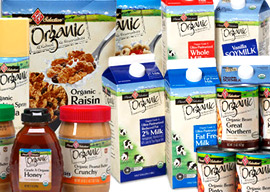food and beverages
Store Brands Headed For 30% Share, Report Finds
- by Karlene Lukovitz @KLmarketdaily, October 15, 2012
 Retailer private-label food brands will grow
from their current 16% to 19% share of U.S. retail food dollar sales to a 25% to 30% share within the next decade, projects a new report from Rabobank’s Food & Agribusiness Research and
Advisory Group.
Retailer private-label food brands will grow
from their current 16% to 19% share of U.S. retail food dollar sales to a 25% to 30% share within the next decade, projects a new report from Rabobank’s Food & Agribusiness Research and
Advisory Group.
By 2025, the U.S. will be on par with the current European scenario, wherein one in three food products purchased is a retailer-branded product, says the report, which points out that U.S. retailer brands’ sales have grown 6% over the past five years, compared with 2% growth for national brands.
National food brands are well aware of the reasons behind private-label’s growth, as detailed in the report.
Essentially, there has been a power shift from CPG companies to food retailers -- not just traditional supermarkets, but retail formats like warehouse clubs and drug store and dollar store chains, which are now increasingly competing with supermarkets for food dollars. Many of these retailers are aggressively expanding private-label into programs offering not just “value” lines, but also lines equivalent to and lines more “premium” than those of national brands -- and packaging and marketing these lines in increasingly sophisticated ways.
advertisement
advertisement
“Retailer brands have matured from their original positioning as 'cheap and cheerless' generic products into a more diverse range of national brand equivalents, and more recently, highly innovative premium products,” sums up Rabobank analyst Nicholas Fereday, author of the report. “On grocery shelves around the U.S., from convenience stores to upscale supermarkets, retail brands now compete successfully and often win against national brands, earning consumer trust in terms of pricing, quality, image and value.”
The big question for national brands, of course, is what strategies to implement in the face of this intense competitive pressure from their own retail customers.
The Rabobank report, which is titled “What Would Apple Do? How Can U.S. Branded Food Companies Withstand the Retailer Brand Onslaught?,” recommends two core strategies:
* Real innovation. “National food brands need to follow the creative model of other industries, funding research that will lead to radical new products that address unmet consumer needs, or create wholly new categories,” stresses the report.
Currently, more than three-quarters of new national-brand food products are line extensions or product derivatives. Meanwhile, in 2011, nearly a third of the new food and beverage items introduced in the U.S. were from retailer brands, according to the Food Marketing Institute. And while many of those were also extensions of existing private-label brand lines, many were genuine product innovations on the part of retailers.
* Go to “Plan B2B.” This strategy is not mutually exclusive from innovating on the national brand products innovation front. However, Rabobank points out that a growing number of CPG companies are diversifying into manufacturing retailer-branded products, leveraging their strengths in R&D, operational know-how, food safety and category management to realize benefits of scale, increase output and sales, and maximize profits.




